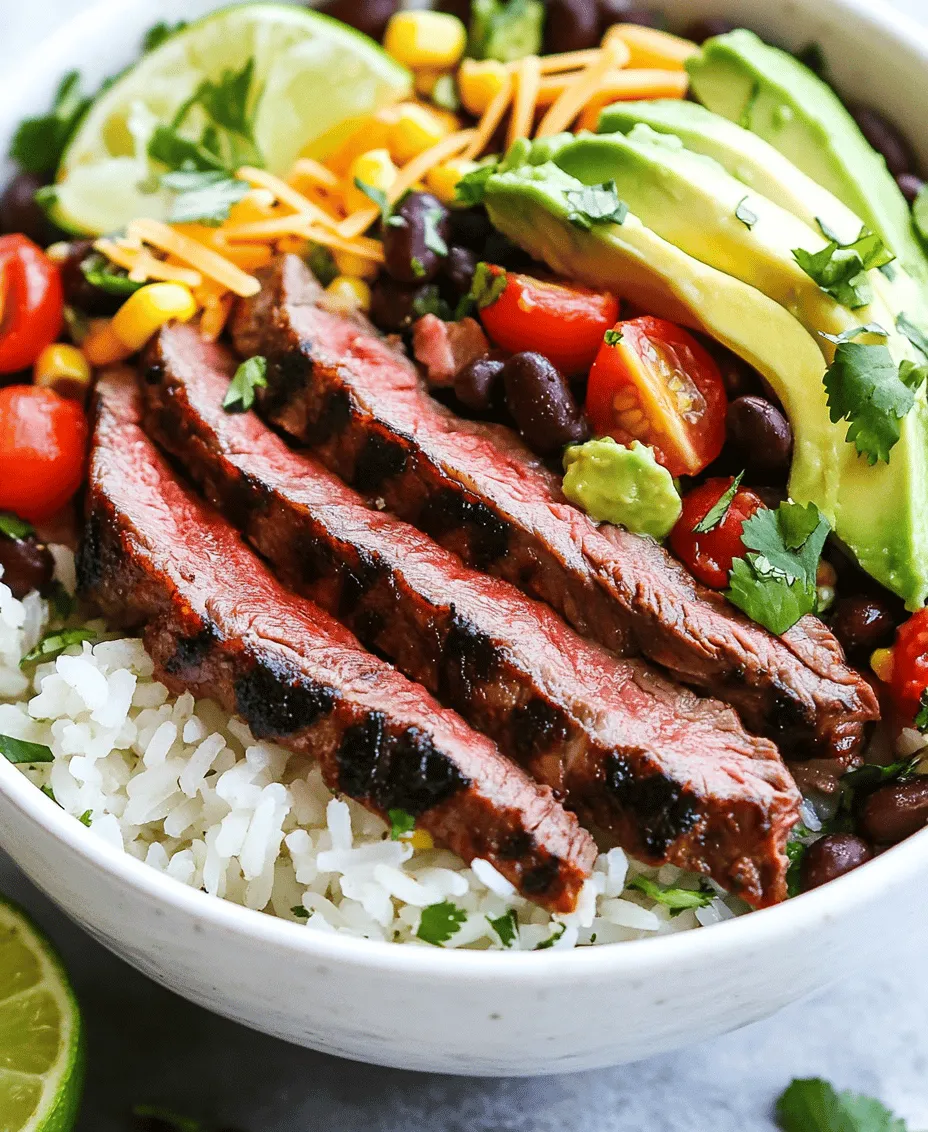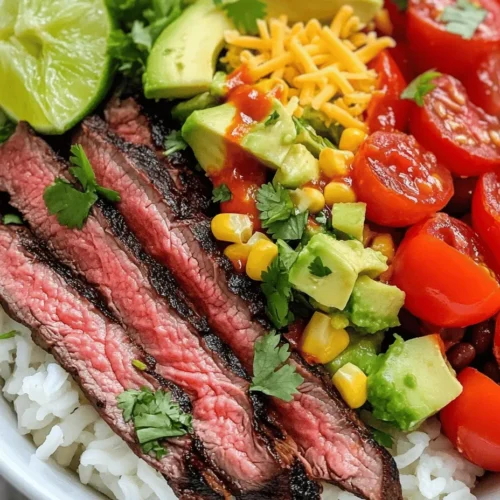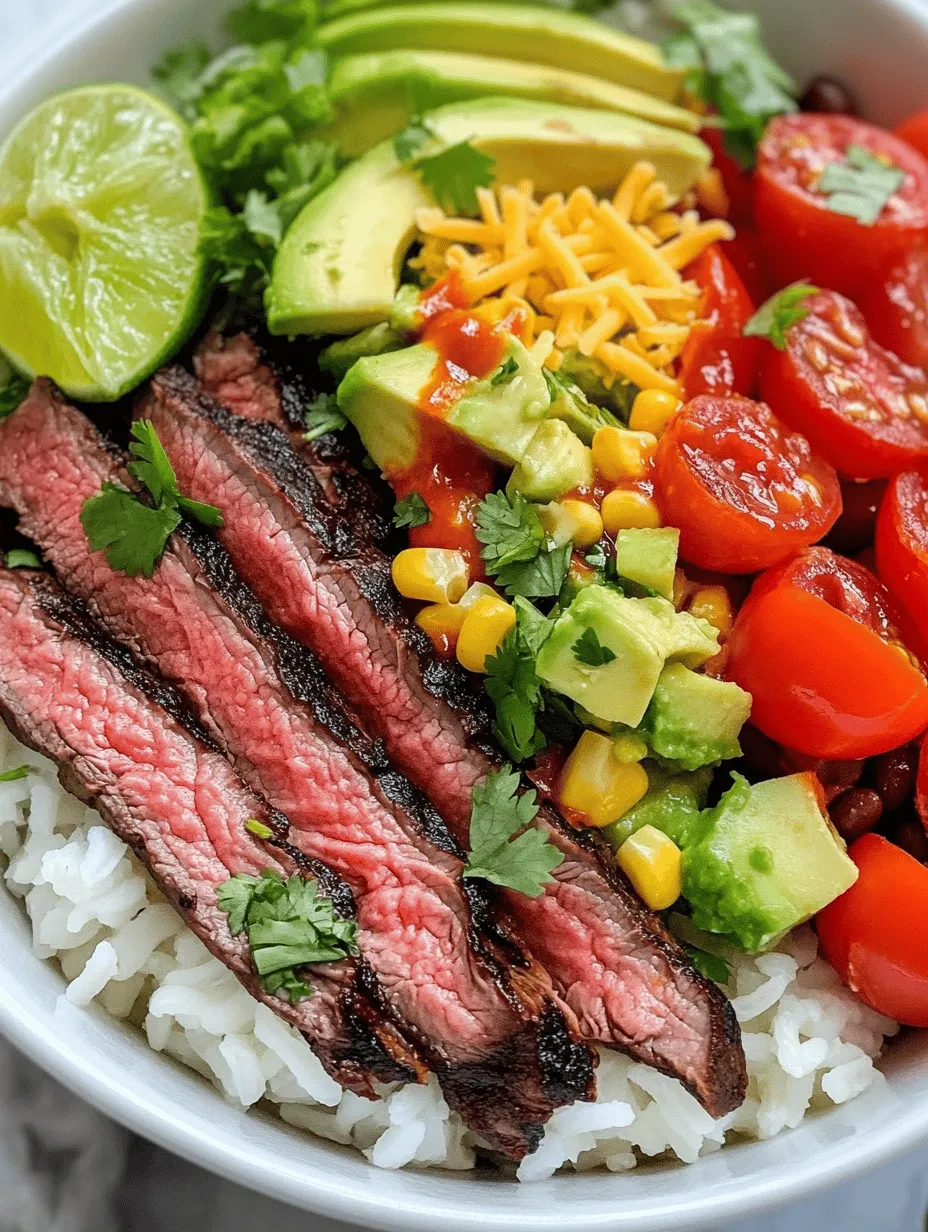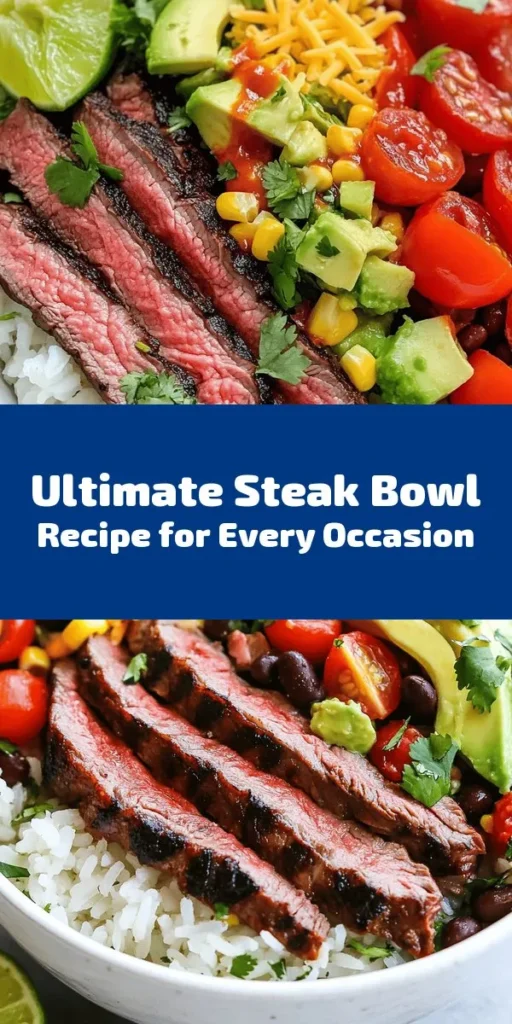Introduction
Steak bowls have surged in popularity in recent years, becoming a go-to dish for food enthusiasts seeking a hearty, satisfying meal. The versatility of steak bowls makes them suitable for a variety of occasions, whether a family dinner, a meal prep session for the week, or a casual gathering with friends. The beauty of a steak bowl lies in its customizability; you can tailor it to suit your taste preferences or dietary needs, making it a perfect option for everyone at the table.
One of the key advantages of making a steak bowl is the opportunity to incorporate nutritious ingredients. From lean protein to vibrant vegetables, each layer of your bowl can contribute to a well-balanced meal. This recipe for the ultimate steak bowl not only highlights the deliciousness of perfectly cooked steak but also emphasizes the health benefits of fresh ingredients and flavorful toppings.
Whether you’re a seasoned chef or a novice in the kitchen, this recipe will guide you through creating a steak bowl that impresses both in taste and presentation. So, let’s dive into the world of steak bowls and set the stage for a delightful culinary experience!
Understanding the Ingredients
To create the ultimate steak bowl, you need to start with high-quality ingredients that not only taste great but also provide nutritional benefits. Let’s explore the key components of this dish:
Flank Steak
Flank steak is the star of the show in our steak bowl, and for good reason. This cut of meat is known for its rich flavor and relatively low-fat content, making it a healthy choice for red meat lovers. Flank steak is a great source of protein, which is essential for muscle repair and growth. Additionally, it contains important nutrients like iron, zinc, and B vitamins, which play a crucial role in overall health.
When selecting flank steak, look for cuts that are bright red in color with minimal marbling. This will ensure a tender and flavorful result when cooked properly.
Olive Oil
Olive oil is another essential ingredient in our recipe, primarily used for marinating the steak. This heart-healthy fat not only enhances the flavor of the steak but also contributes to the overall health benefits of the dish. Rich in monounsaturated fats, olive oil has been linked to reduced inflammation and improved heart health.
In our marinade, olive oil acts as a carrier for the spices, helping to evenly distribute flavors throughout the steak. It also plays a role in tenderizing the meat, ensuring a juicy and succulent final product.
Spices
The right blend of spices can elevate your steak bowl from ordinary to extraordinary. In our recipe, we’ll be using garlic powder, onion powder, and smoked paprika. Each of these spices offers unique flavor profiles that contribute to the overall taste of the dish.
– Garlic Powder: Adds a depth of flavor and a subtle sweetness that complements the savory notes of the steak.
– Onion Powder: Infuses the marinade with a mild onion flavor, enhancing the overall richness of the dish.
– Smoked Paprika: Brings a hint of smokiness that pairs beautifully with grilled steak, giving it that delicious barbecue flavor.
By combining these spices, you’ll create a marinade that not only enhances the steak but also adds complexity to the entire bowl.
Base Ingredients
The base of your steak bowl is crucial for creating a satisfying and filling meal. There are several options to choose from, each with its own nutritional benefits:
– White Rice: A classic choice that provides a neutral flavor and fluffy texture. While it is less nutrient-dense than brown rice, it cooks quickly and pairs well with the bold flavors of the steak and toppings.
– Brown Rice: A whole grain option that is higher in fiber, providing additional health benefits and a nuttier flavor. It takes a bit longer to cook than white rice but is well worth the wait for its nutritional value.
– Cauliflower Rice: For a low-carb alternative, cauliflower rice is a fantastic option. It’s packed with vitamins and minerals while offering a light, fluffy texture that absorbs the flavors of the steak and toppings beautifully.
Fresh Toppings
No steak bowl is complete without fresh toppings that add flavor, texture, and nutritional benefits. Our recipe includes avocado, tomatoes, and cilantro, each of which brings something special to the dish.
– Avocado: Creamy and nutrient-rich, avocados are an excellent source of healthy fats, fiber, and vitamins. They add a luxurious texture to the bowl and help keep you feeling full longer.
– Tomatoes: Juicy and vibrant, tomatoes provide a refreshing contrast to the savory steak. They are rich in antioxidants, particularly lycopene, which is known for its health benefits, including heart health.
– Cilantro: This fresh herb adds a burst of flavor and brightness to the dish. It is also rich in vitamins and may even aid in digestion.
By selecting a combination of these base ingredients and fresh toppings, you’ll create a steak bowl that is not only delicious but also visually appealing and packed with nutrients.
Marinating the Steak
Marinating the steak is a crucial step that enhances both the flavor and texture of the meat. A well-marinated steak will be more tender and flavorful, making your steak bowl truly irresistible.
Importance of Marinating
Marinating serves several purposes. First, it infuses the meat with flavor, allowing the spices and oils to penetrate the steak as it sits. Second, it helps to tenderize the meat, breaking down tough muscle fibers and resulting in a juicier final product. Finally, marinating can help to reduce cooking time, as the flavors have already been developed before the cooking process begins.
Step-by-Step Guide on How to Prepare the Marinade
To create a delicious marinade for your flank steak, follow these simple steps:
1. Gather Your Ingredients: For our marinade, you will need olive oil, garlic powder, onion powder, smoked paprika, salt, and pepper.
2. Combine the Ingredients: In a medium bowl, whisk together 1/4 cup of olive oil, 1 teaspoon of garlic powder, 1 teaspoon of onion powder, 1 teaspoon of smoked paprika, and a generous pinch of salt and pepper. Adjust the quantities according to your taste preferences.
3. Prepare the Steak: Place the flank steak in a resealable plastic bag or a shallow dish. Pour the marinade over the steak, ensuring it is evenly coated.
4. Seal and Refrigerate: Seal the bag or cover the dish with plastic wrap, and refrigerate. Allow the steak to marinate for at least 30 minutes, but for optimal results, aim for 2-4 hours or even overnight. The longer you marinate, the more flavorful and tender the steak will be.
Description of the Marinade Ingredients and Their Roles
– Olive Oil: As mentioned earlier, this ingredient helps to distribute the spices and adds moisture to the meat.
– Garlic Powder, Onion Powder, and Smoked Paprika: These spices work together to create a robust flavor profile that enhances the natural taste of the steak.
– Salt and Pepper: Essential for seasoning, these ingredients help to bring out the flavors of the other components in the marinade.
Recommended Marination Times for Optimal Results
While marinating for 30 minutes will add some flavor, we recommend letting the steak sit in the marinade for at least 2 hours. If you have the time, marinating overnight will yield the best results, allowing the steak to absorb all the flavors fully. Just be cautious not to exceed 24 hours, as the acidity in the marinade can start to break down the meat too much, resulting in a mushy texture.
Cooking the Steak to Perfection
Once your steak has marinated to perfection, it’s time to cook it. The method you choose will significantly influence the flavor and texture of the meat. Here are two popular techniques: grilling and pan-searing.
Techniques for Cooking Steak: Grill vs. Skillet
– Grilling: Cooking your steak on a grill is a fantastic way to achieve that classic charred flavor while also infusing it with smokiness. The high heat of the grill sears the outside, creating a beautiful crust while keeping the inside tender and juicy.
– Skillet: If you don’t have access to a grill, a skillet is an excellent alternative. Using a cast-iron skillet can create a similar sear to that of a grill. The advantage of cooking in a skillet is that you can easily control the heat and add additional flavors, such as butter or herbs, during the cooking process.
Advantages of Each Method in Terms of Flavor and Texture
Both grilling and skillet cooking will produce delicious results, but they do have their differences:
– Grilling tends to impart a smoky flavor and creates beautiful grill marks, which can enhance the visual appeal of your steak bowl.
– Skillet cooking allows for better control over the cooking process, making it easier to achieve your desired level of doneness.
Tips for Achieving the Desired Doneness
To ensure your steak is cooked to perfection, it’s essential to understand the various levels of doneness and their corresponding cooking times:
– Rare: 120°F – 125°F (approximately 2-3 minutes per side)
– Medium-Rare: 130°F – 135°F (approximately 3-4 minutes per side)
– Medium: 140°F – 145°F (approximately 4-5 minutes per side)
– Medium-Well: 150°F – 155°F (approximately 5-6 minutes per side)
– Well-Done: 160°F and above (approximately 6-7 minutes per side)
Use a meat thermometer for the most accurate results, and remember that the steak will continue to cook slightly after being removed from the heat.
Importance of Resting the Steak Post-Cooking
After cooking your steak, let it rest for about 5 to 10 minutes before slicing. This step is crucial as it allows the juices to redistribute throughout the meat, resulting in a more tender and flavorful bite. If you cut into the steak immediately, the juices will run out, leaving you with a drier piece of meat.
Preparing the Bowl Base
While the steak is resting, you can prepare the base of your steak bowl. This step involves cooking your choice of rice or cauliflower rice, depending on your preference.
Detailed Instructions for Cooking Rice
If you’re opting for rice, here are detailed instructions for cooking both white and brown rice:
– White Rice:
1. Rinse 1 cup of white rice under cold water to remove excess starch.
2. In a medium saucepan, bring 2 cups of water to a boil.
3. Add the rinsed rice, a pinch of salt, and reduce the heat to low.
4. Cover and simmer for about 18-20 minutes, or until the rice is tender and the water has been absorbed.
5. Remove from heat and let it sit covered for an additional 5 minutes before fluffing with a fork.
– Brown Rice:
1. Rinse 1 cup of brown rice under cold water.
2. In a medium saucepan, bring 2 1/2 cups of water to a boil.
3. Add the rinsed rice, a pinch of salt, and reduce the heat to low.
4. Cover and simmer for about 40-45 minutes, or until the rice is tender and the water has been absorbed.
5. Remove from heat and let it sit covered for 10 minutes before fluffing with a fork.
– Cauliflower Rice:
1. Remove the leaves from a head of cauliflower and cut it into florets.
2. In a food processor, pulse the florets until they resemble rice grains.
3. In a large skillet, heat 1 tablespoon of olive oil over medium heat.
4. Add the cauliflower rice and sauté for 5-7 minutes until tender.
5. Season with salt and pepper to taste.
Now you’ve got a flavorful base ready for your ultimate steak bowl. With the steak marinated and cooked to perfection, and the bowl base prepared, you’re well on your way to creating a meal that is sure to impress.

Nutritional Comparison of Rice Varieties
When creating the ultimate steak bowl, choosing the right base is crucial, as it can influence not only flavor but also the nutritional profile of your meal. Here, we compare three popular rice options: white rice, brown rice, and cauliflower rice.
– White Rice: This is the most commonly used rice, known for its fluffy texture and neutral flavor. However, it is low in fiber and essential nutrients due to the milling process. One cup of cooked white rice contains approximately 206 calories, 4 grams of protein, 44.5 grams of carbohydrates, and less than 1 gram of fiber.
– Brown Rice: A whole grain option, brown rice retains its bran and germ layers, offering more fiber, vitamins, and minerals. It has a nuttier flavor and chewier texture. One cup of cooked brown rice provides around 215 calories, 5 grams of protein, 45 grams of carbohydrates, and 3.5 grams of fiber, making it a healthier choice compared to white rice.
– Cauliflower Rice: For those looking for a low-carb alternative, cauliflower rice is an excellent option. It is made by grating or processing cauliflower into rice-sized pieces. One cup of cauliflower rice has about 25 calories, 2 grams of protein, 5 grams of carbohydrates, and 2 grams of fiber. It is also rich in vitamins C and K, making it a nutrient-dense choice.
Tips for Preparing Cauliflower Rice
If you decide to go with cauliflower rice, here are some tips to ensure it turns out perfectly:
1. Preparation: Start by removing the leaves and stem from the cauliflower. Cut it into florets and pulse in a food processor until it resembles rice. Alternatively, you can use a box grater.
2. Cooking Techniques: Cauliflower rice can be sautéed, steamed, or microwaved:
– Sautéing: Heat a pan over medium heat, add a little olive oil, and then add the cauliflower rice. Cook for about 5-7 minutes, stirring occasionally until tender.
– Steaming: Place cauliflower rice in a steamer basket over boiling water and steam for 3-5 minutes.
– Microwaving: Place the rice in a microwave-safe bowl, cover it, and microwave for 4-5 minutes.
3. Flavor Enhancements: To boost the flavor of cauliflower rice, consider adding minced garlic, chopped onions, or spices like cumin and paprika while cooking. You can also stir in some freshly chopped herbs or lemon juice before serving for added brightness.
Assembling the Ultimate Steak Bowl
Assembling your ultimate steak bowl is where the fun begins. The key is to layer the ingredients thoughtfully to create a balanced and flavorful dish. Here’s a step-by-step guide:
1. Base Layer: Start with your chosen rice or cauliflower rice as the foundation. Spread it evenly across the bowl.
2. Protein Placement: Add your cooked steak on top of the rice. Slice the steak against the grain to ensure tenderness and maximize flavor.
3. Vegetable Layer: Next, layer in your favorite vegetables. This could include roasted bell peppers, corn, or fresh greens like spinach and arugula. Aim for a variety of colors to enhance visual appeal and provide different textures.
4. Beans and Legumes: If desired, add black beans or chickpeas for added protein and fiber. They also contribute to the bowl’s heartiness.
5. Cheese: Sprinkle some cheese on top, if you like. Cotija, feta, or shredded cheddar work wonderfully here.
6. Garnishes: Finish off with garnishes such as fresh cilantro, lime wedges, and a drizzle of hot sauce or your favorite dressing.
Customization Options
This steak bowl is highly customizable to suit different dietary preferences:
– Vegetarian or Vegan Alternatives: Substitute the steak with grilled portobello mushrooms, tofu, or tempeh. Use nutritional yeast or vegan cheese instead of dairy cheese.
– Gluten-Free Considerations: This recipe is naturally gluten-free. Ensure all condiments and sauces used are gluten-free as well.
Adding the Finishing Touches
Garnishes play a crucial role in elevating the flavor and presentation of your steak bowl:
– Fresh Cilantro: Adds a burst of freshness and a hint of peppery flavor. It complements the richness of the steak beautifully.
– Lime Juice: A squeeze of lime juice brightens up the entire dish, enhancing all the flavors.
– Optional Hot Sauce: For those who enjoy a kick, drizzle on some hot sauce for an extra layer of heat.
– Additional Toppings or Variations: Experiment with different toppings such as sliced avocado, pickled jalapeños, or roasted nuts. Consider adding different beans like pinto or kidney beans for variety.
Serving and Enjoying Your Steak Bowl
When it comes to serving your ultimate steak bowl, presentation can make a big difference:
– Individual Bowls vs. Large Platter: For a casual family dinner, serve individual bowls. For gatherings or parties, consider arranging everything on a large serving platter, allowing guests to build their own bowls.
– Ideal Pairings: Pair your steak bowl with refreshing beverages like iced tea, lemonade, or a crisp white wine. A simple side salad can also complement the meal nicely.
– Versatility: The steak bowl is perfect for various occasions—from casual weeknight dinners and meal prep sessions to impressive dishes for special gatherings. Its adaptable nature allows you to customize it depending on what you have on hand or the preferences of your guests.
Nutritional Information
Understanding the nutritional content of your ultimate steak bowl can help you maintain a balanced diet. Here’s a breakdown per serving:
– Calories: Approximately 550 calories (based on steak, brown rice, and vegetables).
– Protein: Roughly 30-35 grams from the steak and beans.
– Carbohydrates: Around 50-60 grams from the rice and vegetables.
– Fats: Approximately 15-20 grams, mainly from the cheese and any dressing used.
The health benefits of the key ingredients are substantial. Lean steak offers high-quality protein and essential nutrients like iron and zinc. Brown rice provides fiber, supporting digestive health, while a variety of vegetables adds vitamins, minerals, and antioxidants.
Conclusion
The ultimate steak bowl is not just a meal—it’s an experience that combines flavor, nutrition, and customization. Its versatility makes it perfect for any occasion, from a quick weeknight dinner to a festive gathering with friends and family. Don’t hesitate to experiment with different ingredients and flavors to make this recipe your own. Whether you stick to the traditional steak bowl or venture into vegetarian or vegan territory, you’ll create a delicious dish that satisfies every palate. Enjoy the process, and relish every bite!



